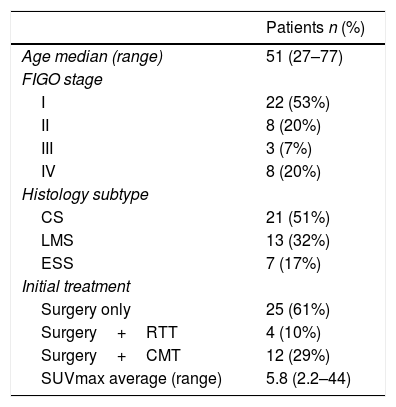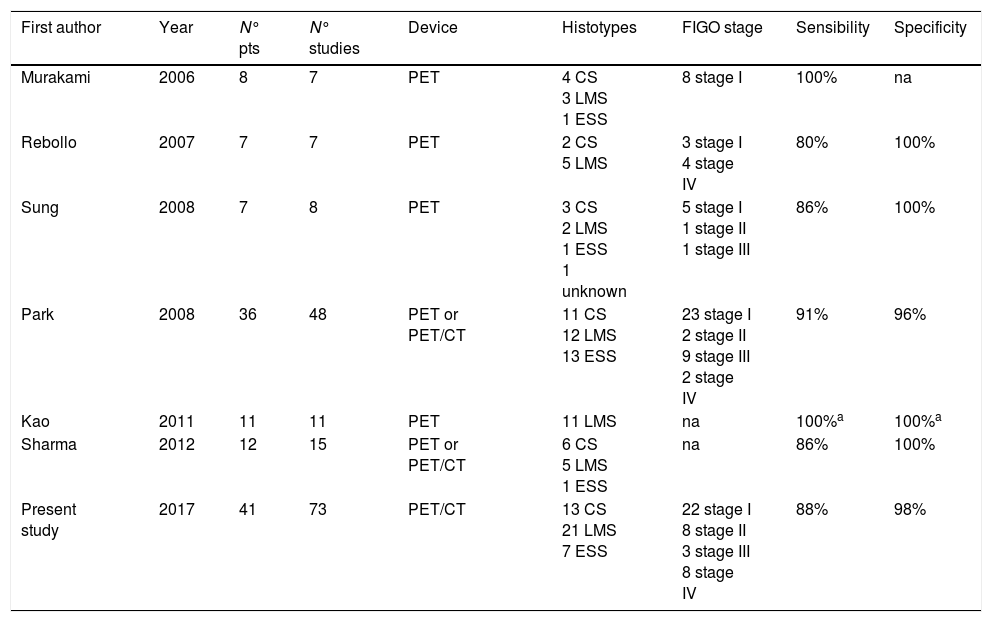Uterine sarcomas are rare tumors with poor prognosis due to the high recurrence rates. The current role of 18F-FDG PET/CT in the post-therapy surveillance is not established yet.
Materials and MethodsForty-one women with uterine sarcoma underwent 73 18F-FDG PET/CT for restaging in suspected recurrence or during follow-up in asymptomatic patients. Histopathology results and/or clinical/imaging follow-up for at least 12 months were considered the reference standard. The diagnostic accuracy and clinical impact of 18F-FDG PET/CT was calculated.
ResultsThirty-three 18F-FDG PET/CT were positive, while the remaining 40 studies were negative. The overall sensitivity, specificity, positive predictive value (PPV), negative predictive value (NPV) and accuracy of 18F-FDG PET/CT were 88%, 98%, 97%, 91% and 93%, respectively. Considering patients with clinical or radiological suspicion of recurrence (n=47) and those during follow-up (n=26), sensitivity, specificity, PPV, NPV and accuracy of 18F-FDG PET/CT were 89%, 100%, 100%, 86% and 94%, and 80%, 95%, 80%, 95% and 92%, respectively. 18F-FDG PET/CT had a positive clinical impact in 9/73 (12%) studies and changed the clinical management in 8/41 (20%) patients.
Conclusions18F-FDG PET/CT seems to be an accurate method for detection and localization of local and distant recurrence in patients with uterine sarcoma with good sensitivity and specificity and significant impact on clinical decision making.
Los sarcomas uterinos son tumores raros con mal pronóstico debido a las altas tasas de recurrencia. El papel actual de la 18F-FDG PET/TC en la vigilancia posterior a la terapia aún no está establecido.
Material y metodosCuarenta y una mujeres con sarcoma uterino se sometieron a 73 estudios 18F-FDG PET/TC para la reestadificación en la presunta recurrencia o durante el seguimiento en pacientes asintomáticos. Los resultados histopatológicos y/o el seguimiento clínico/de imágenes durante al menos 12 meses se consideraron el estándar de referencia. Se calculó la precisión diagnóstica y el impacto clínico de la 18F-FDG PET/TC.
Resultadostreinta y tres estudios 18F-FDG PET/TC fueron positivos, mientras que los 40 estudios restantes fueron negativos. La sensibilidad general, la especificidad, el valor predictivo positivo (VP+), el valor predictivo negativo (VP-) y la precisión de la 18F-FDG PET/TC fueron del 88%, 98%, 97%, 91% y 93%. Considerando pacientes con sospecha clínica o radiológica de recidiva (n=47) y durante el seguimiento (n=26) la sensibilidad y especificidad, VP+, VP− y precisión de 18F-FDG PET/TC fueron del 89%, 100%, 100%, 86% y 94%, y 80%, 95%, 80%, 95% y 92% respectivamente. La 18F-FDG PET/TC tuvo un impacto clínico positivo en 9/73 (12%) estudios y cambió el manejo clínico en 8/41 (20%) pacientes.
ConclusionLa 18F-FDG PET/TC es un método preciso para la detección y localización de recidivas a distancia en pacientes con sarcoma uterino con buena sensibilidad y especificidad e impacto significativo en la toma de decisiones clínicas.
Article

Revista Española de Medicina Nuclear e Imagen Molecular (English Edition)











